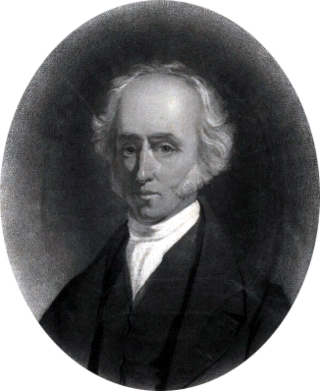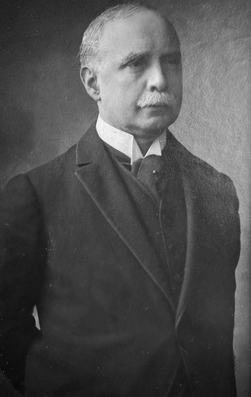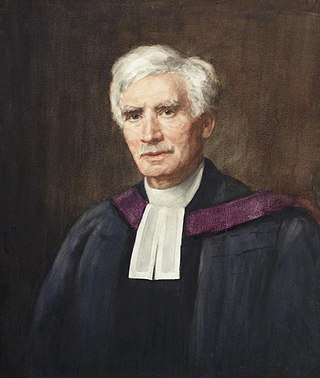Related Research Articles

The Dean Cemetery is a historically important Victorian cemetery north of the Dean Village, west of Edinburgh city centre, in Scotland. It lies between Queensferry Road and the Water of Leith, bounded on its east side by Dean Path and on its west by the Dean Gallery. A 20th-century extension lies detached from the main cemetery to the north of Ravelston Terrace. The main cemetery is accessible through the main gate on its east side, through a "grace and favour" access door from the grounds of Dean Gallery and from Ravelston Terrace. The modern extension is only accessible at the junction of Dean Path and Queensferry Road.

Tain is a royal burgh and parish in the County of Ross, in the Highlands of Scotland.

The Free Church of Scotland is a Scottish denomination which was formed in 1843 by a large withdrawal from the established Church of Scotland in a schism known as the Disruption of 1843. In 1900, the vast majority of the Free Church of Scotland joined with the United Presbyterian Church of Scotland to form the United Free Church of Scotland. In 1904, the House of Lords judged that the constitutional minority that did not enter the 1900 union were entitled to the whole of the church's patrimony ; the residual Free Church of Scotland acquiesced in the division of those assets, between itself and those who had entered the union, by a Royal Commission in 1905. Despite the late founding date, Free Church of Scotland leadership claims an unbroken succession of leaders going back to the Apostles.

Sir George Adam Smith was a Scottish theologian. He was the Principal of the University of Aberdeen between 1909 and 1935 and an important figure in the United Free Church of Scotland.

David Welsh FRSE was a Scottish Presbyterian minister and academic. He was Moderator of the General Assembly of the Church of Scotland in 1842. In the Disruption of 1843 he was one of the leading figures in the establishment of the Free Church of Scotland.

Strathnaver or Strath Naver is the fertile strath of the River Naver, a famous salmon river that flows from Loch Naver to the north coast of Scotland. The term has a broader use as the name of an ancient province also known as the Mackay Country, once controlled by the Clan Mackay and extending over most of northwest Sutherland.

The Grange is an affluent suburb of Edinburgh, just south of the city centre, with Morningside and Greenhill to the west, Newington to the east, The Meadows park and Marchmont to the north, and Blackford Hill to the south. It is a conservation area characterised by large early Victorian stone-built villas and mansions, often with very large gardens. The Grange was built mainly between 1830 and 1890, and the area represented the idealisation of country living within an urban setting.

Alexander Munro was a British sculptor of the Pre-Raphaelite movement. He concentrated on portraiture and statues, but is best known for his Rossetti-influenced figure-group Paolo and Francesca (1852), which has often been identified as the epitome of Pre-Raphaelite sculpture.

Robert Gordon FRSE was a Scottish minister and author. Originally prominent in the Church of Scotland, and serving as Moderator of the General Assembly in 1841, following the Disruption of 1843 he joined the Free Church of Scotland and became a prominent figure in that church.
Sir Hector Munro, 1st Baronet of Foulis was a Scottish soldier, noble and clan chief of the highland Clan Munro. He is also by tradition the 19th Baron and 22nd overall chief of the clan. He is however the 12th chief of the Clan Munro who can be proved by contemporary evidence.

Clan Munro is a Highland Scottish clan. Historically the clan was based in Easter Ross in the Scottish Highlands. Traditional origins of the clan give its founder as Donald Munro who came from the north of Ireland and settled in Scotland in the eleventh century, though its true founder may have lived much later. It is also a strong tradition that the Munro chiefs supported Robert the Bruce during the Wars of Scottish Independence. The first proven clan chief on record however is Robert de Munro who died in 1369; his father is mentioned but not named in a number of charters. The clan chiefs originally held land principally at Findon on the Black Isle but exchanged it in 1350 for Estirfowlys. Robert's son Hugh who died in 1425 was the first of the family to be styled "of Foulis", despite which clan genealogies describe him as 9th baron.
Events from the year 1835 in Scotland.
Events from the year 1800 in Scotland.
Thomas Brown (1811–1893) was a Scottish minister in the Free Church of Scotland who rose to its highest rank, Moderator of the General Assembly in 1890. He was a noted geologist and botanist. He wrote prolifically on the history of the Disruption of 1843.
Events from the year 1774 in Scotland.

Sir Robert William Philip was a Scottish physician and pioneer in the treatment and control of tuberculosis.

William Paterson Paterson FRSE DD LLD (1860–1939) was a Scottish minister of the Church of Scotland. He was professor of divinity at the University of Edinburgh from 1904 to 1934. He served as Moderator of the General Assembly of the Church of Scotland in 1919. He was central to the reunification of the United Free Church of Scotland with the Church of Scotland in 1929.
Thomas McLauchlan (1815–1886) was a Scottish minister and theological author who served as Moderator of the General Assembly for the Free Church of Scotland 1876/77.
William Nixon (1803–1900) was a Scottish minister of the Free Church of Scotland who served as Moderator of the General Assembly in 1868/69. In Montrose he was nicknamed the "Lion of St John's".

Robert Paul was a Scottish banker and church elder that was director of the Commercial Bank of Scotland.
References
- ↑ "Sutherland and the Reay country - Histories of Scottish families". National Library of Scotland. p. 370.
- ↑ "Am Baile". Am Baile.
- ↑ Biographical Index of Former Fellows of the Royal Society of Edinburgh 1783 – 2002 (PDF). The Royal Society of Edinburgh. July 2006. ISBN 0-902-198-84-X.
- ↑ History of the UF Church
- ↑ The Athenaeum (journal) 1912
- ↑ Ewing, William Annals of the Free Church